New paper led by @Diversity_Turn MSc student @DomiSchwab out in @JAppliedEcology!
Predation is a key ecosystem function – but which factors influence predation rate and predator composition in #vanilla #agroforestry?
A thread about our findings https://abs.twimg.com/emoji/v2/... draggable="false" alt="👇" title="Rückhand Zeigefinger nach unten" aria-label="Emoji: Rückhand Zeigefinger nach unten">
https://abs.twimg.com/emoji/v2/... draggable="false" alt="👇" title="Rückhand Zeigefinger nach unten" aria-label="Emoji: Rückhand Zeigefinger nach unten"> https://abs.twimg.com/emoji/v2/... draggable="false" alt="👇" title="Rückhand Zeigefinger nach unten" aria-label="Emoji: Rückhand Zeigefinger nach unten">
https://abs.twimg.com/emoji/v2/... draggable="false" alt="👇" title="Rückhand Zeigefinger nach unten" aria-label="Emoji: Rückhand Zeigefinger nach unten"> https://abs.twimg.com/emoji/v2/... draggable="false" alt="👇" title="Rückhand Zeigefinger nach unten" aria-label="Emoji: Rückhand Zeigefinger nach unten"> 1/15
https://abs.twimg.com/emoji/v2/... draggable="false" alt="👇" title="Rückhand Zeigefinger nach unten" aria-label="Emoji: Rückhand Zeigefinger nach unten"> 1/15
Predation is a key ecosystem function – but which factors influence predation rate and predator composition in #vanilla #agroforestry?
A thread about our findings
In north-eastern #Madagascar  https://abs.twimg.com/emoji/v2/... draggable="false" alt="🇲🇬" title="Flagge von Madagaskar" aria-label="Emoji: Flagge von Madagaskar">, vanilla agroforests, rice paddies, land under shifting cultivation, forest fragments and old-growth forests form a diverse mosaic landscape. 2/15
https://abs.twimg.com/emoji/v2/... draggable="false" alt="🇲🇬" title="Flagge von Madagaskar" aria-label="Emoji: Flagge von Madagaskar">, vanilla agroforests, rice paddies, land under shifting cultivation, forest fragments and old-growth forests form a diverse mosaic landscape. 2/15
Importantly, #vanilla agroforests differ in land-use history: they can be established on fallow land or inside forests, with strong implications for #Biodiversity and #EcosystemFunctions
See this thread about our paper in @ConLetters: 3/15 https://twitter.com/Dominic_Mart/status/1272429539713519623">https://twitter.com/Dominic_M...
See this thread about our paper in @ConLetters: 3/15 https://twitter.com/Dominic_Mart/status/1272429539713519623">https://twitter.com/Dominic_M...
. @DomiSwb visited all our 80 @Diversity_Turn plots across seven land-use types to measure predation rate. 4/15
But how to measure predation rate? 5/15
He used fake caterpillars  https://abs.twimg.com/emoji/v2/... draggable="false" alt="🐛" title="Käfer" aria-label="Emoji: Käfer"> – standardized plasticine dummies – to measure 1) predation rate and 2) predator composition which he assessed by bitemark identification.
https://abs.twimg.com/emoji/v2/... draggable="false" alt="🐛" title="Käfer" aria-label="Emoji: Käfer"> – standardized plasticine dummies – to measure 1) predation rate and 2) predator composition which he assessed by bitemark identification.
36 dummies per plot were exposed for 48 hours – summing up to 2880 exposures in total. 6/15
36 dummies per plot were exposed for 48 hours – summing up to 2880 exposures in total. 6/15
Predation rates where highest in the unburned land-use types old-growth forest, forest fragment and forest-derived vanilla. Rice paddies showed the smallest rates, but heterogeneity within land-use was high throughout. 7/15
In-depth analysis revealed that on-plot stem- and vegetation density were both positively associated with predation rate cross land-use types. 8/15
However, landscape-scale forest cover was also positively associated with predation rate. Predation rate differed between unburned and burned plots (that were once used for shifting hill rice cultivation). 9/15
The bitemark analysis further revealed differences in predator composition: Ants  https://abs.twimg.com/emoji/v2/... draggable="false" alt="🐜" title="Ameise" aria-label="Emoji: Ameise"> were the most important predators throughout, but predation by other groups, especially Gryllacrididae, differed between land-use types. 10/15
https://abs.twimg.com/emoji/v2/... draggable="false" alt="🐜" title="Ameise" aria-label="Emoji: Ameise"> were the most important predators throughout, but predation by other groups, especially Gryllacrididae, differed between land-use types. 10/15
These differences in predator composition also became apparent in an NMDS. Particularly old-growth forest and forest fragments featured a different set of predators than all other land-use types. 11/15
Our results show that:
- Measuring predation rates is possible with dummy caterpillars
- Predation rates – a key ecosystem function - decline with tree loss on the plot- and landscape-scale.
- The plots’ land-use history determines the predator community 12/15
- Measuring predation rates is possible with dummy caterpillars
- Predation rates – a key ecosystem function - decline with tree loss on the plot- and landscape-scale.
- The plots’ land-use history determines the predator community 12/15
We also show that it is possible to reliably identify various predators from bitemarks – even in a tropical location.
This showed a shift in predator composition across the land-use gradient & showed that Malagassy Gryllacrididae are particularly vulnerable to LUC. 13/15
This showed a shift in predator composition across the land-use gradient & showed that Malagassy Gryllacrididae are particularly vulnerable to LUC. 13/15
Congratulations @DomiSwb to this achievement & thanks for having me on board!
We are grateful to all involved farmers, to Gatien Rasolofonirina for field assistance, to @VWStiftung for funding, and to #ProjektDeal for #OpenAccess!
Paper link: https://doi.org/10.1111/1365-2664.13766">https://doi.org/10.1111/1...
14/15
We are grateful to all involved farmers, to Gatien Rasolofonirina for field assistance, to @VWStiftung for funding, and to #ProjektDeal for #OpenAccess!
Paper link: https://doi.org/10.1111/1365-2664.13766">https://doi.org/10.1111/1...
14/15
btw: If you are more of a bird person: one of my PhD chapters investigates (endemic) bird diversity across the same land-use types & is now out in @Biotropica!
https://www.doi.org/10.1111/btp.12859">https://www.doi.org/10.1111/b... 15/15
https://www.doi.org/10.1111/btp.12859">https://www.doi.org/10.1111/b... 15/15

 Read on Twitter
Read on Twitter https://abs.twimg.com/emoji/v2/... draggable="false" alt="👇" title="Rückhand Zeigefinger nach unten" aria-label="Emoji: Rückhand Zeigefinger nach unten">https://abs.twimg.com/emoji/v2/... draggable="false" alt="👇" title="Rückhand Zeigefinger nach unten" aria-label="Emoji: Rückhand Zeigefinger nach unten"> 1/15" title="New paper led by @Diversity_Turn MSc student @DomiSchwab out in @JAppliedEcology!Predation is a key ecosystem function – but which factors influence predation rate and predator composition in #vanilla #agroforestry?A thread about our findings https://abs.twimg.com/emoji/v2/... draggable="false" alt="👇" title="Rückhand Zeigefinger nach unten" aria-label="Emoji: Rückhand Zeigefinger nach unten">https://abs.twimg.com/emoji/v2/... draggable="false" alt="👇" title="Rückhand Zeigefinger nach unten" aria-label="Emoji: Rückhand Zeigefinger nach unten">https://abs.twimg.com/emoji/v2/... draggable="false" alt="👇" title="Rückhand Zeigefinger nach unten" aria-label="Emoji: Rückhand Zeigefinger nach unten"> 1/15" class="img-responsive" style="max-width:100%;"/>
https://abs.twimg.com/emoji/v2/... draggable="false" alt="👇" title="Rückhand Zeigefinger nach unten" aria-label="Emoji: Rückhand Zeigefinger nach unten">https://abs.twimg.com/emoji/v2/... draggable="false" alt="👇" title="Rückhand Zeigefinger nach unten" aria-label="Emoji: Rückhand Zeigefinger nach unten"> 1/15" title="New paper led by @Diversity_Turn MSc student @DomiSchwab out in @JAppliedEcology!Predation is a key ecosystem function – but which factors influence predation rate and predator composition in #vanilla #agroforestry?A thread about our findings https://abs.twimg.com/emoji/v2/... draggable="false" alt="👇" title="Rückhand Zeigefinger nach unten" aria-label="Emoji: Rückhand Zeigefinger nach unten">https://abs.twimg.com/emoji/v2/... draggable="false" alt="👇" title="Rückhand Zeigefinger nach unten" aria-label="Emoji: Rückhand Zeigefinger nach unten">https://abs.twimg.com/emoji/v2/... draggable="false" alt="👇" title="Rückhand Zeigefinger nach unten" aria-label="Emoji: Rückhand Zeigefinger nach unten"> 1/15" class="img-responsive" style="max-width:100%;"/>
 , vanilla agroforests, rice paddies, land under shifting cultivation, forest fragments and old-growth forests form a diverse mosaic landscape. 2/15" title="In north-eastern #Madagascar https://abs.twimg.com/emoji/v2/... draggable="false" alt="🇲🇬" title="Flagge von Madagaskar" aria-label="Emoji: Flagge von Madagaskar">, vanilla agroforests, rice paddies, land under shifting cultivation, forest fragments and old-growth forests form a diverse mosaic landscape. 2/15" class="img-responsive" style="max-width:100%;"/>
, vanilla agroforests, rice paddies, land under shifting cultivation, forest fragments and old-growth forests form a diverse mosaic landscape. 2/15" title="In north-eastern #Madagascar https://abs.twimg.com/emoji/v2/... draggable="false" alt="🇲🇬" title="Flagge von Madagaskar" aria-label="Emoji: Flagge von Madagaskar">, vanilla agroforests, rice paddies, land under shifting cultivation, forest fragments and old-growth forests form a diverse mosaic landscape. 2/15" class="img-responsive" style="max-width:100%;"/>

 – standardized plasticine dummies – to measure 1) predation rate and 2) predator composition which he assessed by bitemark identification. 36 dummies per plot were exposed for 48 hours – summing up to 2880 exposures in total. 6/15" title="He used fake caterpillars https://abs.twimg.com/emoji/v2/... draggable="false" alt="🐛" title="Käfer" aria-label="Emoji: Käfer"> – standardized plasticine dummies – to measure 1) predation rate and 2) predator composition which he assessed by bitemark identification. 36 dummies per plot were exposed for 48 hours – summing up to 2880 exposures in total. 6/15" class="img-responsive" style="max-width:100%;"/>
– standardized plasticine dummies – to measure 1) predation rate and 2) predator composition which he assessed by bitemark identification. 36 dummies per plot were exposed for 48 hours – summing up to 2880 exposures in total. 6/15" title="He used fake caterpillars https://abs.twimg.com/emoji/v2/... draggable="false" alt="🐛" title="Käfer" aria-label="Emoji: Käfer"> – standardized plasticine dummies – to measure 1) predation rate and 2) predator composition which he assessed by bitemark identification. 36 dummies per plot were exposed for 48 hours – summing up to 2880 exposures in total. 6/15" class="img-responsive" style="max-width:100%;"/>



 were the most important predators throughout, but predation by other groups, especially Gryllacrididae, differed between land-use types. 10/15" title="The bitemark analysis further revealed differences in predator composition: Ants https://abs.twimg.com/emoji/v2/... draggable="false" alt="🐜" title="Ameise" aria-label="Emoji: Ameise"> were the most important predators throughout, but predation by other groups, especially Gryllacrididae, differed between land-use types. 10/15" class="img-responsive" style="max-width:100%;"/>
were the most important predators throughout, but predation by other groups, especially Gryllacrididae, differed between land-use types. 10/15" title="The bitemark analysis further revealed differences in predator composition: Ants https://abs.twimg.com/emoji/v2/... draggable="false" alt="🐜" title="Ameise" aria-label="Emoji: Ameise"> were the most important predators throughout, but predation by other groups, especially Gryllacrididae, differed between land-use types. 10/15" class="img-responsive" style="max-width:100%;"/>




